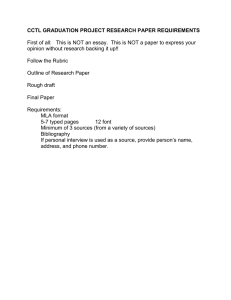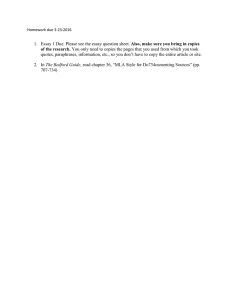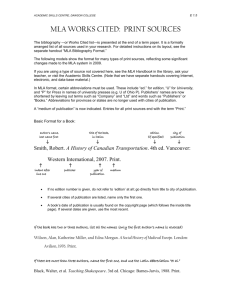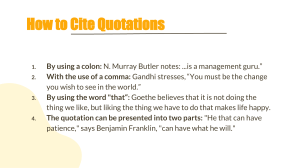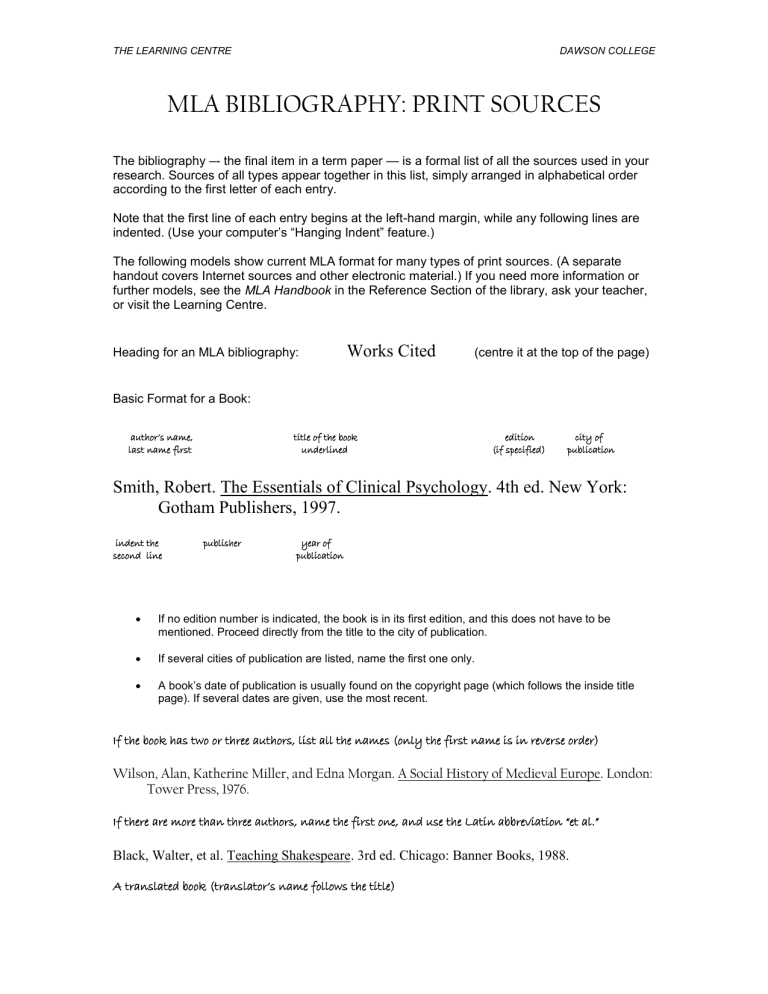
THE LEARNING CENTRE DAWSON COLLEGE MLA BIBLIOGRAPHY: PRINT SOURCES The bibliography –- the final item in a term paper — is a formal list of all the sources used in your research. Sources of all types appear together in this list, simply arranged in alphabetical order according to the first letter of each entry. Note that the first line of each entry begins at the left-hand margin, while any following lines are indented. (Use your computer’s “Hanging Indent” feature.) The following models show current MLA format for many types of print sources. (A separate handout covers Internet sources and other electronic material.) If you need more information or further models, see the MLA Handbook in the Reference Section of the library, ask your teacher, or visit the Learning Centre. Heading for an MLA bibliography: Works Cited (centre it at the top of the page) Basic Format for a Book: author’s name, last name first title of the book underlined edition (if specified) city of publication Smith, Robert. The Essentials of Clinical Psychology. 4th ed. New York: Gotham Publishers, 1997. indent the second line publisher year of publication If no edition number is indicated, the book is in its first edition, and this does not have to be mentioned. Proceed directly from the title to the city of publication. If several cities of publication are listed, name the first one only. A book’s date of publication is usually found on the copyright page (which follows the inside title page). If several dates are given, use the most recent. If the book has two or three authors, list all the names (only the first name is in reverse order) Wilson, Alan, Katherine Miller, and Edna Morgan. A Social History of Medieval Europe. London: Tower Press, 1976. If there are more than three authors, name the first one, and use the Latin abbreviation “et al.” Black, Walter, et al. Teaching Shakespeare. 3rd ed. Chicago: Banner Books, 1988. A translated book (translator’s name follows the title) THE LEARNING CENTRE DAWSON COLLEGE Malraux, André. Man’s Fate. Trans. H. M. Chevalier. New York: Random House, 1961. An essay in a book of essays (author of the essay is named first; editor’s name follows the book title; entry ends with page numbers of the entire essay) Porter, Ellen B. “The Bureaucratic Elite.” Essays on Canadian Politics. Ed. Timothy Barnes. Toronto: York Publishers, 1991. 56-59. A poem or short story in an anthology (as above, entry ends with page numbers of the entire item) Chopin, Kate. “The Story of an Hour.” America’s Short Fiction. Ed. Grace G. Millar. Chicago: Midwest Press, 1978. 121-125. Article in a weekly or monthly periodical (following the title of the magazine / journal, give the date or month of the issue, the year, and then the page numbers of the entire article) Anderson, James. “Springtime in Patagonia.” National Geographic Oct. 1997: 46-51. Journal article in a periodical that is published annually or several times a year (if pages are numbered continuously through all issues of the year, give the volume number only) Woodridge, Frank. “The Private Company.” Business Law Quarterly 56 (1990): 317-331. but if the journal’s pages are numbered separately in each issue, include the issue number following the volume number, as shown here: …Business Law Quarterly 56.3 (1990): 317-331. Newspaper article (if the city is not part of the newspaper’s name, include it in square brackets) Fisk, Roberta. “The Threat of Global Warming.” The Gazette [Montreal] 17 Jan. 1999: D12. Pamphlet (treated like a book; if no individual author is named, begin with the title) Reducing Cancer Risks in the Workplace. Washington: American Cancer Society, 2001. Encyclopedia article---signed (begin with the name of the article’s author) Tucker, David G. “Sonar.” Encyclopedia Americana. 15th ed. Encyclopedia article—unsigned (begin with the article’s heading) “India.” Encyclpaedia Britannica: Macropaedia. 1995 ed.
